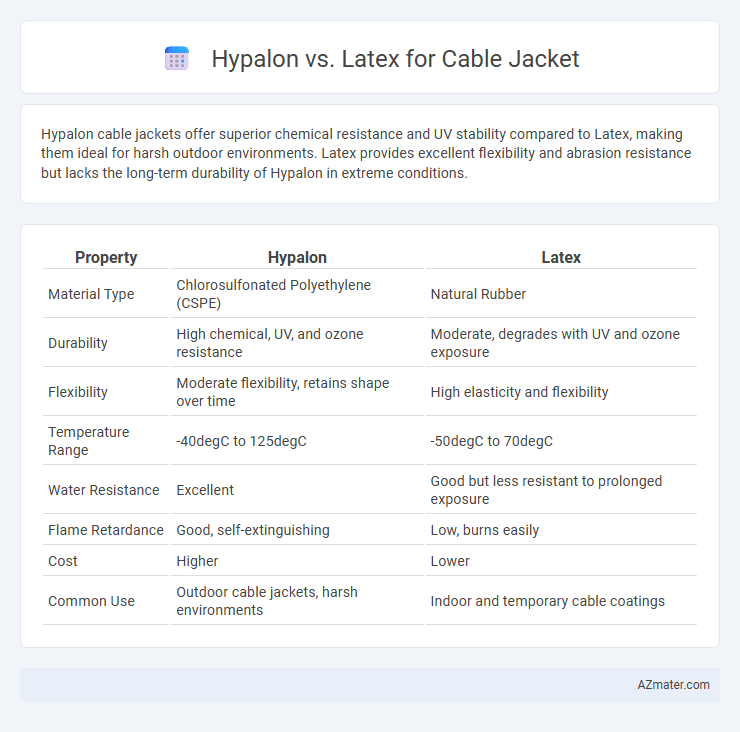Hypalon cable jackets offer superior chemical resistance and UV stability compared to Latex, making them ideal for harsh outdoor environments. Latex provides excellent flexibility and abrasion resistance but lacks the long-term durability of Hypalon in extreme conditions.
Table of Comparison
| Property | Hypalon | Latex |
|---|---|---|
| Material Type | Chlorosulfonated Polyethylene (CSPE) | Natural Rubber |
| Durability | High chemical, UV, and ozone resistance | Moderate, degrades with UV and ozone exposure |
| Flexibility | Moderate flexibility, retains shape over time | High elasticity and flexibility |
| Temperature Range | -40degC to 125degC | -50degC to 70degC |
| Water Resistance | Excellent | Good but less resistant to prolonged exposure |
| Flame Retardance | Good, self-extinguishing | Low, burns easily |
| Cost | Higher | Lower |
| Common Use | Outdoor cable jackets, harsh environments | Indoor and temporary cable coatings |
Introduction to Cable Jacket Materials
Hypalon and latex are two distinct materials used in cable jacket manufacturing, each offering unique protective properties. Hypalon, a chlorosulfonated polyethylene, provides excellent resistance to chemicals, UV light, and extreme weather, making it ideal for outdoor and industrial cables. Latex, a natural rubber material, offers superior flexibility and elasticity but has limited resistance to environmental factors compared to Hypalon, often making it more suitable for indoor or less demanding applications.
What Is Hypalon?
Hypalon is a synthetic rubber known for its superior resistance to chemicals, extreme weather, and UV radiation, making it an ideal material for cable jackets requiring long-term durability. Unlike latex, Hypalon offers enhanced protection against ozone and abrasion, ensuring cables maintain integrity in harsh environments. Its tough, non-porous surface is favored in industrial and outdoor applications where cable longevity and safety are critical.
What Is Latex?
Latex is a natural or synthetic rubber material known for its excellent flexibility, elasticity, and resistance to abrasion, making it a reliable choice for cable jackets in certain environments. Unlike Hypalon, which is a chlorosulfonated polyethylene known for its exceptional chemical and UV resistance, latex cable jackets offer superior softness and bendability but generally have lower resistance to harsh chemicals and outdoor elements. Latex is preferred in applications where flexibility and comfort are critical, but not in extreme weather or highly corrosive conditions.
Key Properties of Hypalon
Hypalon cable jackets offer superior chemical resistance, excellent weatherability, and strong UV stability, making them ideal for harsh outdoor environments. Their high resistance to abrasion, ozone, and a wide temperature range ensures long-lasting durability and protection for cables. Hypalon also provides excellent electrical insulation and flame retardance, outperforming latex in demanding industrial applications.
Key Properties of Latex
Latex cable jackets offer excellent elasticity, flexibility, and resistance to abrasion, making them ideal for applications requiring frequent bending and movement. Their natural water repellency and good insulating properties enhance electrical safety and durability in humid or wet environments. Though less resistant to chemicals and UV exposure compared to Hypalon, latex excels in providing superior grip and comfort in handling cables.
Durability Comparison: Hypalon vs Latex
Hypalon cable jackets offer superior chemical resistance, UV stability, and abrasion resistance, making them far more durable than latex in harsh environments. While latex provides excellent flexibility and elasticity, it lacks the long-term weathering and ozone resistance that Hypalon delivers. Consequently, Hypalon jackets are preferred for outdoor and industrial applications requiring extended service life and robust protection.
Chemical and Weather Resistance
Hypalon cable jackets excel in chemical resistance, showing strong durability against acids, alkalis, and solvents, making them ideal for harsh industrial environments. Latex jackets offer good flexibility and elasticity but have limited chemical and weather resistance, often degrading quickly under UV exposure and harsh chemicals. For applications requiring superior resistance to ozone, UV rays, and a broad range of chemicals, Hypalon provides a more durable and weather-resistant protective solution.
Flexibility and Handling
Hypalon cable jackets offer excellent flexibility and chemical resistance, making them suitable for harsh environments requiring frequent handling and bending. Latex jackets provide superior elasticity and softness, enhancing flexibility and ease of installation in applications demanding high maneuverability. Selecting between Hypalon and Latex depends on the balance needed between chemical durability and the softness needed for smooth handling.
Typical Applications for Hypalon and Latex Jackets
Hypalon cable jackets are commonly used in harsh industrial environments, including chemical plants, mining, and marine applications, due to their excellent resistance to chemicals, UV radiation, and extreme temperatures. Latex cable jackets are typically favored for medical, electronic, and low-voltage power cables where flexibility and softness are essential, as well as in consumer electronics due to their good insulation properties. Hypalon excels in outdoor and heavy-duty applications, while latex is preferred for indoor and light-duty cable protection.
Which Material Is Best for Your Cable?
Hypalon offers superior chemical resistance and UV stability, making it ideal for harsh outdoor environments, while latex provides excellent flexibility and abrasion resistance at a lower cost. For cables exposed to extreme weather, chemicals, or sunlight, Hypalon jackets ensure longer durability and protection. Latex jackets suit applications requiring flexibility and moderate environmental resistance but may degrade faster under prolonged UV exposure.

Infographic: Hypalon vs Latex for Cable jacket
 azmater.com
azmater.com